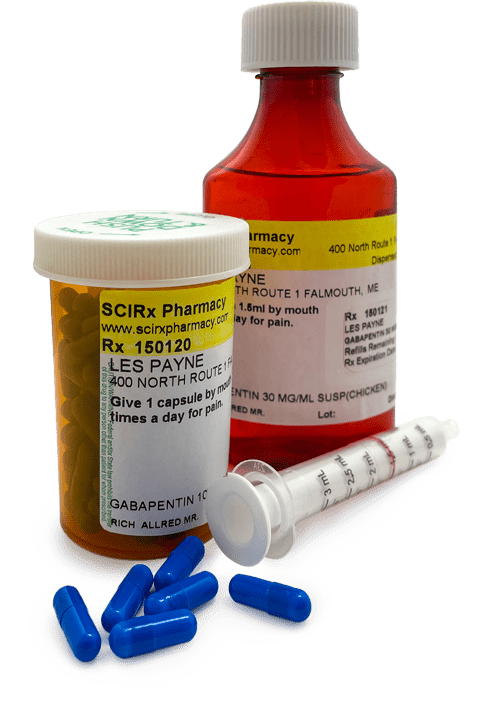Welcome to the first in a series of Drug Highlights from SCIRx Pharmacy. We hope you find the information helpful, please call us if you have any questions.
Gabapentin is a medication belonging to a drug group called anticonvulsants. Initially used in the treatment of seizures, Gabapentin was found to be a useful medication for chronic pain, especially nerve pain. Although the use of Gabapentin in veterinary medicine is considered off-label, many veterinarians have used it routinely and effectively for many years with excellent results.
The primary mechanism of action is not known, but the drug is structurally like gamma-aminobutyric acid (GABA), an inhibitory neurotransmitter responsible for communication in the central nervous system. GABA blocks signals associated with seizures, pain, and anxiety. Gabapentin appears to work in a similar manner to the body’s natural GABA.
Gabapentin is commonly prescribed for dogs and cats with chronic pain from conditions such as osteoarthritis, spondylosis, intervertebral disc disease, and many more. It is particularly effective when used in combination with other pain-relievers, including non-steroidal anti-inflammatory medications like meloxicam and carprofen. Gabapentin is not as effective for acute pain because of the way it works in the brain.
As well as being used for chronic pain, Gabapentin is commonly used to calm the animal and to reduce anxiety in stressful situations. We often find it prescribed to calm the pet prior to veterinary visits or long trips.
It is commercially available as a tablet, capsule, and oral liquid. Some brands of manufactured liquid formulations can contain the sweetener Xylitol, which is severely toxic to dogs. Gabapentin is not considered a controlled substance by the federal government but several states now consider Gabapentin a schedule V controlled substance. In those states, there are stricter regulations regarding the prescribing and dispensing of the medication.
The recommended dose range of Gabapentin is quite broad, with plenty of scope for adjustment. Doses can gradually be increased if the pet tolerates the medication and shows improvement. The daily dose of Gabapentin is typically split into two or three doses throughout the day.
Sedation and lack of coordination are the key side effects of concern though they are temporary and resolve in a few hours. Cats may also vomit or drool but, again, these side effects should resolve within 8 hours of receiving the medication. Diarrhea has also been reported.
Gabapentin is removed from the body through the kidneys. If the pet has kidney insufficiency the dose should be modified, or another product should be considered.
Gabapentin can cause a false positive reading on urine dipstick tests for urinary protein Gabapentin should not be abruptly discontinued after long-term use as seizures can be precipitated. Instead, Gabapentin should be gradually tapered off over a couple of weeks.
At SCIRx Pharmacy, we compound Gabapentin into several different formulation types, which include:
• Capsules (Both Standard and Easy-to-Open)
• Several different types of Oral Suspensions
• Flavored Chews
• Transdermal Cream
When prescribing Gabapentin, several factors should be considered when selecting the most appropriate formulation for the animal. The dosage and concentration selected will vary depending on the condition being treated. The weight of the animal and species will dictate the dosage needed.
Each formulation has its advantages and limitations. Below is a brief explanation of each.
Capsules
More commonly used with dogs than in cats, capsules can be compounded to the exact dose needed for the animal. In some situations, the pet owner can open the capsules and mix the contents of the capsule with the animal’s food. In those situations, we can provide Easy – to – Open capsules assisting the pet owner in administering.
Suspensions
More commonly used in cats, we can compound the suspension, and tailor the dose to the requirement of the animal. Of the liquid suspension options, the oil-based formulations offer the longest dating of 90 days, compared to the water and meat-based suspensions that have 30-day dating. Based on our experience, Gabapentin formulated into a triple-fish meat-based suspension, has good acceptance
by cats. Our triple-fish formulation is a good choice when Gabapentin is being administered regularly i.e for pain control.
On a general note, a cat’s nose is many times more sensitive than our own. They also have what might be described as an auxiliary sense. The roof of a cat’s mouth contains a biological structure called Jacobson’s organ. It connects the mouth to the nasal passage. It is believed that animals with this organ use it to “taste-smell” aromas around them such as food and pheromones
Cats are obligate carnivores and are driven to consume meat. They do not need to eat sugar or carbohydrates (that turn to sugar), thus there is no reason for them to have a taste for it . . . or a sweet tooth, if you will. Essentially, the taste receptors that react to meat and the fat contained therein, are what drive a cat’s appetite.
Dr. Amy Nichelason, feline practitioner, and assistant clinical professor, at the University of Wisconsin–Madison School of Veterinary Medicine, recently reported several findings when attempting to examine the acceptance of differently compounded flavors for cat medications.
- Cats do not like sweet flavors in water-based formulations.
- Often, veterinarians use a client’s judgment to determine flavor preference for medication, but Dr. Nichelason found that owners might not be the best predictors of what their cats will prefer.
- Although no individual flavor stuck out as a winner overall, cats favored oil-based flavorings over water-based flavorings. There were some trends toward preferences within the oil-based flavorings (specifically, chicken and fish), but these findings were not statistically significant.
She suggested avoiding sweet flavors and using oil-based flavorings when possible. Dr. Nichelson also suggested trying different formulations — chews, liquids, or tablets — based on what your cat likes.
Gabapentin is a hydrochloride salt, as a result, formulations with higher concentrations are associated with reduced pet acceptance due to the bitter taste of the drug. A cat’s bitter and sour taste sensors are important in that they warn of harmful and/or poisonous foods or objects. We have found the acceptance of the liquid formulations to be better if you keep the concentration of the gabapentin at or below 50mg/ml. It is always a balance between the concentration and volume in determining the best solution.
The temperature of the medication at the time of administration is also something to consider. Felines will usually show a preference toward warmer food, approximately 100 degrees Fahrenheit, which mimics the temperature of freshly killed prey. Many cats will reject a cold dish of food just taken from a refrigerator.
Chews
Another compounded option available from SCIRx is our medicated chews. We offer two different size chews our trademarked MediMorsel, the similar size of a pencil eraser, and the larger TheraChew about the size of a gum chicklet. Both the MediMorsel and TheraChew are made from the same ingredients, with the only difference being their size. The MediMorsel averages around 550 mg in weight and the TheraChew comes in at around 1000 mg.
Most of our chews are formulated as MediMorsels. We tend to reserve the TheraChew situations when we run into concentration/taste issues. Both the MediMorsel and TheraChew are available in several flavors, with chicken and fish being the most common.
Similar to the liquid suspensions, we have found the acceptance of Gabapentin formulated in the MediMorsel best if we keep the concentration at or below 25 or 30 mg per chew. We routinely provide pet owners unmedicated chews to help determine if the chew is a viable consideration.
Transdermal Cream
If the pet is not able to take Gabapentin orally, then the use of a transdermal cream can be considered.
We can formulate Gabapentin into a transdermal cream up to a concentration of 25mg/ 0.1 ml.
When considering this route, a limiting factor is the actual amount of drug that can be absorbed thru the skin of the ear. In addition, at a concentration of 25mg/0.1ml, the transdermal cream is too thick in consistency for use in our dial-a-dose applicator and must be dispensed in 1ml oral syringes.
Some limited studies have shown that Gabapentin in a transdermal base penetrates feline skin in vitro, and is absorbed systemically in cats. The limited findings seem to suggest that the transdermal route may be reasonable in the treatment of cats.
Future studies evaluating the use of transdermally administered Gabapentin in cats with the administration over longer periods of time, and also comparing various concentrations need to be performed.
If you have a situation where you are considering the use of Gabapentin and have questions, please call one of our pharmacists to review the situation and we can assist you in selecting the best format for the pet.
Regards
Rich Allred RPh.
Owner – SCIRx Pharmacy

